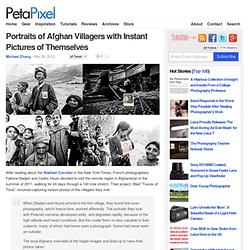

Kabul - a city at work. Portraits of Afghan Villagers with Instant Pictures of Themselves. After reading about the Wakhan Corridor in the New York Times, French photographers Fabrice Nadjari and Cedric Houin decided to visit the remote region in Afghanistan in the summer of 2011, walking for 24 days through a 140 mile stretch.

Their project, titled “Traces of Time”, involved capturing instant photos of the villagers they met: When [Nadjari and Houin] arrived in the first village, they found that even photographs, which freeze time, worked differently. The portraits they took with Polaroid cameras developed oddly, and degraded rapidly, because of the high altitude and harsh conditions. But this made them no less valuable to their subjects, many of whom had never seen a photograph. Some had never seen an outsider.The local Afghans marveled at the fragile images and lined up to have their photos taken. A Hard Trek to Humility (via Photojojo) Image credits: Photographs by Fabrice Nadjari and Cedric Houin. Art in the streets of Kabul.
Inside the blackened ruin of Kabul's cultural centre, a spray-painting of a woman in a burqa sits at the foot of a staircase to nowhere, beside a line of poetry mourning everything that has been lost to Afghanistan in three decades of violence. The painting is the work of Shamsia Hassani, 24, probably her country's first serious graffiti artist. "The water can come back to a dried-up river, but what about the fish that died? " is her translation of the line, written under gaping holes gouged through the concrete walls by shells when battles raged through the area. "When I heard this poem, I thought how it was about the situation in Afghanistan. A lot of people died in the war; now the situation is better, but those people cannot come back," said Hassani. An associate professor of sculpture at Kabul University, she draws, paints in oil, and is a founding member of a contemporary art collective, Rosht, or "growth".
She has embraced the discipline. Or she does fantasy graffiti. Afghanistan. “Given the images people see on TV, many conclude Afghanistan never made it out of the Middle Ages.

But that is not the Afghanistan I remember. I grew up in Kabul in the 1950s and ’60s. Stirred by the fact that news portrayals of the country’s history didn’t mesh with my own memories, I wanted to discover the truth. “Remembering Afghanistan’s hopeful past only makes its present misery seem more tragic. But it is important to know that disorder, terrorism, and violence against schools that educate girls are not inevitable. . - Mohammad Qayoumi “A laboratory at the Vaccine Research Center.” “A villager welcomes visiting nurses to his compound.”
“Biology class, Kabul University.” “Cabinet in session.” “Central control panel at Radio Kabul transmitter. “Fresh fruit bazaar.” “Furniture display room.” “Gulbahar Textile Plant is one of the most modern in Asia.”